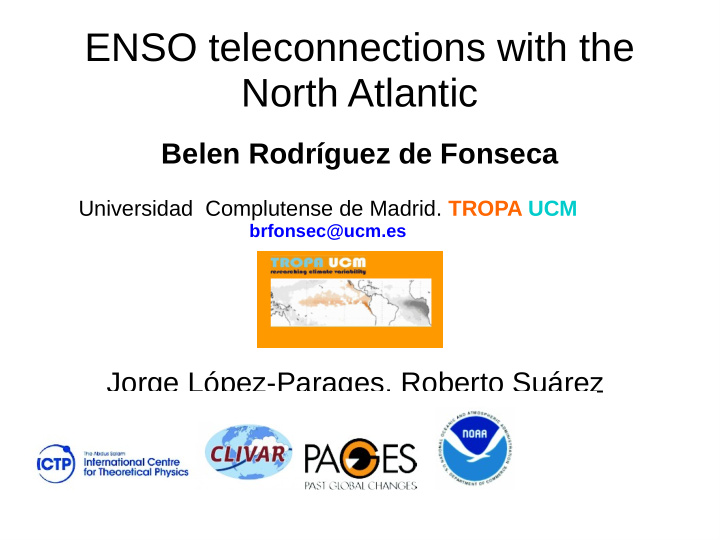



ENSO teleconnections with the North Atlantic Belen Rodríguez de Fonseca Universidad Complutense de Madrid. TROPA UCM brfonsec@ucm.es Jorge López-Parages, Roberto Suárez Elsa Mohino, Teresa Losada
• T eleconnections provide a paradigm for understanding connections between remote climates • They can be interpreted in terms of Rossby Waves North Atlantic Region e c t i o n T e l e c o n A h t h e w i t r o p i c a l e x t r a t A t l a n t i c : N o r t h u r o p e E Teleconection with Tropical Atlantic:Sahel
Alexander et al. J. Climate 2002
Teleconnection mechanisms within the tropics: Equatorial waves – Gill solution Equatorial heating (Jin and Hoskins, 1995) (Gill, 1980) Courtesy of Teresa Losada
Teleconnection mechanisms within the tropics: Equatorial waves – Gill solution Rodwell, 2001 Equatorial heating (Gill, 1980) Courtesy of Teresa Losada (Jin and Hoskins, 1995) - + The response to El Niño - over the Sahel is a reduction of rainfall Mohino et al., 2011 Giannini et al, 2003
Teleconnection mechanisms with the extratropics: Mechanism: Rossby Waves Barotropic in the extratropics Baroclinic in the tropic (Hoskins y Karoly, 1981; Liu y Alexander, 2007)
Teleconnection mechanisms with the extratropics: Mechanism: Rossby Waves (Hoskins y Karoly, 1981; Liu y Alexander, 2007) Brönnimann (2007) In Europe and the Mediterranean region the impacts are stronger in late winter- spring (and fall) Regression between ENSO index and surface air temperature and SLP
This is stationary view
Nevertheless ,teleconnections depends on the upper level mean flow as Rossby waves propagation depend on its intensity and location Stationary wave number Depends of the jet meanders and intensity Arching patterns of Rossby Waves propagates through the weakenings of the jet
How does decadal variability affect interanual teleconnections? Thermal wind equation Regions with strong SST gradients can change the mean flow
Hypothesis Teleconnections in terms of Rossby Waves depend on the climatological upper level winds. Changes in the intensity of the upper level winds are related to changes in the SST gradients. Teleconnections with extratropical north Atlantic requires weakening of the jet. Teleconnections with the tropics requieres changes in mean Walker circulation. Decadal SST modes exhibit strong meridional and zonal gradients which could change the way in which the teleconnection take place.
Do we see this in observations? -extratropics -tropics
Do we see this in observations? Europe López Parages and Rodríguez de Fonseca, 2012. Geophysical Research Lett.
Do we see this in observations? Europe López Parages and Rodríguez de Fonseca, Correlations are inverse in sign 2012. Geophysical Research Lett. to match the AMV
SST decadal patterns How about CMIP5 models? Pi-control simulations López Parages et al (submitted to J Climate)
SST decadal patterns CMIP5 models Clim. U200 (contour) Diff in N & P (shading) K P- N (shading) López Parages et al (submitted to J Climate)
Telec. In N Telec. In P SST. In P SST. In N EL Niño forcing have opposite impacts depending of the period CMIP5 models López Parages et al (submitted to J Climate)
Do we see this in observations? Sahel Losada et al., 2012 n ___ Atl3 vs Guinean rainfall Rodríguez-Fonseca et al. 2015, J Climate ___ Niño3 vs Guinean rainfall ___ Niño 3 vs Sahel rainfall ___ Atl3 vs Sahel rainfall
How do these modulations affect predictability? S4CAST model: Suárez-Moreno and Rodríguez-Fonseca, 2015 (GMD) Suárez-Moreno et al (in preparation): multidecadal changes in the interanual SST-forced Station data (Sanogo et al., 2015). teleconnections with the Sahel
How do these modulations affect predictability? S4CAST model: Suárez-Moreno and Rodríguez-Fonseca, 2015 (GMD) Suárez-Moreno et al (in preparation): multidecadal changes in the interanual SST-forced teleconnections with the Sahel
How does the ENSO response change at multidecadal time scale? JAS EOF of the 20-yr regression maps done between Psi200 and Niño34 in JAS along 20th century From ERA-20CR Streamfunction response: a) In positive phases of pattern A (contours) b) In negative phases of pattern (shadings) strengthening of the Walker Cell Weakening of the Walker Cell pattern A Evolution of pattern in A Rodríguez-Fonseca et al (in preparation) 50% of the variance
conclusions ENSO teleconnections should be interpreted as the sum of a stationary and a non stationary component. The non-stationary component of ENSO teleconnection varies at multidecadal timescales, acording to decadal oceanic patterns. These decadal changes are related to changes in the upper level winds, which determine the response to a thermal forcing, changing the wave guides and associated teleconnection patterns. In Europe, the AMV global patterm seems to be responsible of changes in the upper level winds, which determine the existence of teleconnections (more effective in negative AMV) CMIP5 models exhibit multidecadal modulation of El Niño according with a PDO-AMV pattern. In Sahel, the response changes with a trend pattern related to changes in the mean Walker circulation, which determines the location of the response to an equatorial diabatic heating. The non-stationarity of ENSO teleconnection and the existence of a multidecadal modulation opens windows of oportunity when predicting with ENSO.
Recommend
More recommend